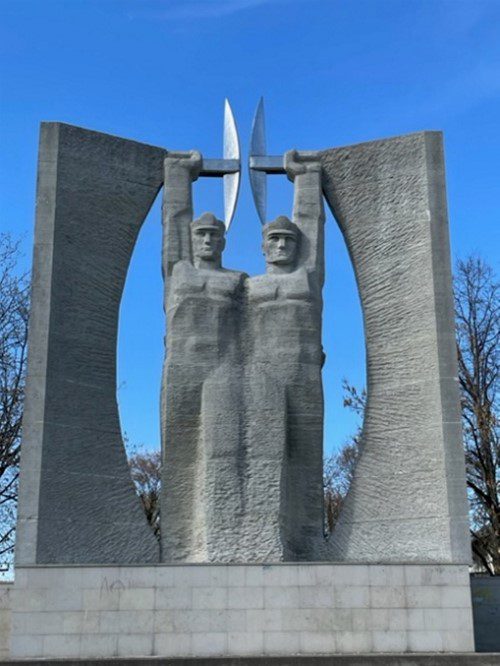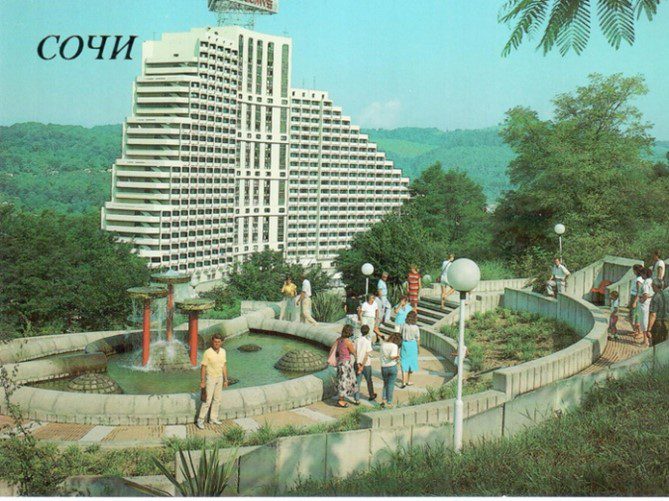White Vest Imaginaries: On the Afterlife of Soviet-Extractivist Masculinities

Image Credit: “Glory to Work” Monument in Kohtla-Järve, Estonia © Katherine Fama 2023
Pictured here is Kohtla-Järve’s “Glory to Work”, a monument erected in the Estonian Soviet Socialist Republic (1967) to commemorate the 50th anniversary of the October Revolution. Though built to boast the perseverance and dedication of Soviet miners, with both men raising their pickaxes proudly to demonstrate working solidarity, the statue would earn the colloquial moniker “Two Teetotopes”, or “the only two sober miners”. This is an intriguing testament to the construction of hegemonic Soviet-extractivist masculinities, at once represented as resolute and imminent – built in the image of the Soviet Union’s own self-reflection, but also predicated on a heavy drinking culture. This Soviet-extractivist cultural legacy of promoting men’s intensive drinking is not made evident through the formal aesthetics of Soviet art itself, but through the tongue-in-cheek moniker attached to the artwork by local communities. This hints towards the idea that the façade of this brutalist-imperialist aesthetic rests atop an unregistered context of cultural trauma, exhaustion, and the disparity between Soviet cultural production and the reality of Soviet-extractivist masculinity.

This got me thinking, if not a little fascinated, over the ideals of Soviet hegemonic masculinities, how these ideals affected the lives and labour of Soviet miners, and what the legacy of those Soviet-extractivist masculinities were in a post-Soviet post-extractivist landscape. In a curator’s tour of the Kohtla-Järve Museum of Shale-Oil, Professor Linda Kaljundi and Dr Tiina-Mall Kreem, led us through a tour of Estonian and Soviet-era art depicting miners and oil-shale thermal power plant workers, including work painted by Olev Soans (1960). Many of the artworks had been state funded to illustrate the indomitable spirit of Soviet men and promote faith in the Soviet Union as a system powered by the labour of honest, hard-working, and handsome men. Notice the white vest worn by the worker on the right and how it frames him as a heroic example of the masculine ideal. He stands ready to work, a comrade unadorned and unexaggerated, yet the vest is unstained and blocked boldly in white, with shading only to contour his muscular physique. This represents both the purity of his labour and his modesty, where moral goodness is associated with his ability to work on to support the needs of the state.

There is a palpable yet unregistered sense of pain in these depictions of Soviet-extractivist masculinities which is symptomatic of the disconnect between state-sponsored cultural production and the lived experience of the people. Displays of hard-working and brawny men in Marlon Brando-esque vests exaggerates the virulence of the Soviet Union, yet from our tour of the Estonian Mining Museum in Kohtla-Nõmme, we learned that those very vests were the source of tremendous suffering. Our guide, Jüri Sala, told us about how, during one particularly harrowing mining accident, the sparks from a misfired explosive caused the men’s vests to catch fire. He told us about how equipment and clothing were often unregulated underground and men’s complaints about workplace injuries were consistently unreported, because if word of mining accidents and safety violations reached Moscow then those in charge would lose their end-of-year bonus. This is intriguing, as it puts the dangerous and precarious reality of Soviet-extractivist masculinities at the peripheries of the Soviet Union into direct conflict with the idealised imaginaries of cheap labour and fearless men being produced in Moscow.

During this trip, I kept being brought back to the thought that the afterlife of these Soviet-extractivist masculinities are still found in the almost tongue-in-cheek Dionysian imaginaries of Soviet sanatoriums today. Sanatoria themselves were designated for different echelons of Soviet-extractivist society, with locations in places like Sochi, pictured above, being reserved for only “elite” workers. Despite these inequities, there is a certain sense of release and celebration that haunts the idea of Soviet sanatoriums, where strapping young men came to let off steam after working the mines. Professor Eeva Kesküla told us about how, during her field research visits to sanatoriums, it was perceived as a disappointment to not have a fleeting affair with someone, as she remembers one woman commenting that “she had burned her holiday voucher”. However, Professor Kesküla also noted that the sanatoriums were also referred to as “the place of love and tears”, and that many men had serious underlying health conditions as a result of their mining labour which affected their libidos. This schism between love and tears is similar to the split that exists between Soviet-extractivist realities and imaginaries, where the Soviet miner’s potency is upheld to propagate notions of unwavering sovereignty.
This brings us back to the blithe alcoholism of the Two Teetotopes, where the mitigation of physical and emotional trauma is framed as a Dionysian celebration of the worker’s prowess. Faith in the Soviet Union was largely predicated on the dependability of extractivist labour, and so the cultural production of ideal Soviet-extractivist masculinities worked to embed assumptions about the desires and capacities of miners into the Soviet Union’s cultural imaginary. Today, Estonia is transitioning away from extractivist economies, and the state’s national development plan limits annual mining, part of a larger negotiation with the European Commission to support a Just Transition Fund. Estonia, as a post-Soviet nation transitioning away from extractivist dependency, is in the exciting process of unpacking the masculine ideals perpetuated by the Soviet Union and rethinking the roles of gender and sexuality the state’s history. Tallinn University held a lecture series on Soviet and Socialist LGBT histories in 2016 which confronted the volatile politics of memory and reframed Soviet history with queerness and social justice as a focal point. These developments in the nation’s gender politics herald a wider global future, where just transitions away from carbon-dependency are inspiring thinkers and artists to reimagine cultural norms beyond petromodernity.

– CALEB O’CONNOR, University College Dublin
List of References
Kesküla, E. (2018) ‘Oasis in the Steppe: Health and masculinity of Kazakhstani miners’, Central Asian Survey, 37, pp. 546-562.
Männi, O. and Iwaska. U. (1967) Glory to Work, Kohtla-Järve.
Omidi, M. (2017) Holidays in Soviet Sanatoriums, FUEL.
PASHA. (2021) LGBT USSR, Fragment Gallery, Moscow.
Sloans, O. (1960), Balti Soojuselektrijaam XI, Oil Shale Museum, Kohtla-Järve.